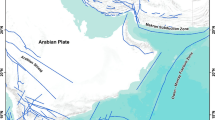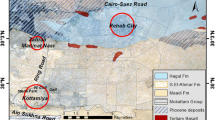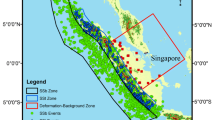Abstract
The region around Taiwan is known for active seismicity, and a few studies have reported a high seismic hazard in this region, including a deterministic seismic hazard analysis (DSHA) study. Essentially, DSHA is to estimate earthquake ground motions considering the worst-case earthquake size and location, but without considering the seismic hazards from non-controlling sources. Understandably, when many non-controlling sources are present, the original DSHA framework could be insufficient. Therefore, using the extreme probability theory, this study introduces a new DSHA framework taking non-controlling seismic sources into account during DSHA calculations. The new method was applied to a seismic hazard assessment for Taiwan, showing that near the conjunctions of seismic source zones, the increase in seismic hazard could be substantial after considering a total of 19 non-controlling sources. More importantly, like other seismic hazard assessments for Taiwan, this study conveys the same alarming message that a high level of seismic hazard should be present around the region.








Similar content being viewed by others
References
Ang AHS, Tang WH (2007) Probability concepts in engineering: emphasis on applications to civil and environmental engineering. Wiley, New Jersey
Bommer JJ (2003) Uncertainty about the uncertainty in seismic hazard analysis. Eng Geol 70:165–168
Bozzoni F, Corigliano M, Lai CG, Salazar W, Scandella L, Zuccolo E, Latchman J, Lynch L, Robertson R (2011) Probabilistic seismic hazard assessment at the eastern Caribbean islands. Bull Seism Soc Am 101:2499–2521
Caltrans (2006) Seismic design criteria. California Department of Transportation. http://www.dot.ca.gov/hq/esc/techpubs/manual/othermanual/other-engin-manual/seismic-design-criteria/sdc.html
Castanos H, Lomnitz C (2002) PSHA: is it science? Eng Geol 66:315–317
Cheng CT, Chiou SJ, Lee CT, Tsai YB (2007) Study on probabilistic seismic hazard maps of Taiwan after Chi–Chi earthquake. J Geo Eng 2:19–28
Geller RJ, Jackson DD, Kagan YY, Mulargia F (1997) Earthquake cannot be predicted. Science 275:1616
Greensfelder RW (1974) Maximum credible rock acceleration from earthquakes in California. California Department of Conservation, Division of Mines and Geology Map Sheet 23
Hasse JS, Choi YS, Bowling T, Nowack RL (2011) Probabilistic seismic hazard assessment including site effects for Evansville, Indiana, and the surrounding region. Bull Seism Soc Am 101:1039–1054
Klugel JU (2007) Error inflation in probabilistic seismic hazard analysis. Eng Geol 90:186–192
Klugel JU (2008) Seismic hazard analysis—Quo vadis? Earth-Sci Rev 88:1–32
Kolathayar S, Sitharam TG (2012) Comprehensive probabilistic seismic hazard analysis of the Andaman-Nicobar Regions. Bull Seism Soc Am 102:2063–2076
Kramer SL (1996) Geotechnical earthquake engineering. Prentice Hall Inc., New Jersey
Krinitzsky EL (2003) How to combine deterministic and probabilistic methods for assessing earthquake hazards. Eng Geol 70:157–163
Mualchin L (1996) Development of the Caltrans deterministic fault and earthquake hazard map of California. Eng Geol 42:217–222
Mualchin L (2005) Seismic hazard analysis for critical infrastructures in California. Eng Geol 79:177–184
Musson RMW (2012a) PSHA validated by quasi observational means. Seismol Res Lett 83:130–134
Musson RMW (2012b) Probability in PSHA: Reply to “Comment on ‘PSHA validated by quasi observational means’ by Z. Wang”. Seismol Res Lett 83:717–719
R.O.C. Construction and Planning Agency (2005) Seismic design code for buildings in Taiwan. R.O.C. Ministry of the Interior
Sokolov VY, Loh CH, Wen KL (2000) Empirical study of sediment-filled basin response: the case of Taipei City. Earthq Spectra 16:681–707
Sokolov VY, Wen KL, Miksat J, Wenzel F, Chen CT (2009) Analysis of Taipei Basin response for earthquakes of various depths and locations using empirical data. Terr Atmos Ocean Sci 20:687–702
USNRC (2007) A performance-based approach to define the site-specific earthquake ground motion. Regulatory Guide 1.208. United States Nuclear Regulatory Commission
Wang Z (2012) Comment on “PSHA validated by quasi observational means” by R.M.W. Musson. Seismol Res Lett 83:714–716
Wang JP, Chan CH, Wu YM (2011) The distribution of annual maximum earthquake magnitude around Taiwan and its application in the estimation of catastrophic earthquake recurrence probability. Nat Hazards 59:553–570
Wang JP, Brant L, Wu YM, Taheri H (2012a) Probability-based PGA estimations using the double-lognormal distribution: including site-specific seismic hazard analysis for four sites in Taiwan. Soil Dyn Earthq Eng 42:177–183
Wang JP, Chang SC, Wu YM, Xu Y (2012b) PGA distributions and seismic hazard evaluations in three cities in Taiwan. Nat Hazards 64:1373–1390
Wang JP, Huang D, Yang Z (2012c) Deterministic seismic hazard map for Taiwan developed using an in-house Excel-based program. Comput Geosci 48:111–116
Wang JP, Huang D, Cheng CT, Shao KS, Wu YC, Chang CW (2013a) Seismic hazard analysis for Taipei City including deaggregation, design spectra, and time history with Excel applications. Comput Geosci 52:146–154
Wang JP, Huang D, Chang SC (2013b) Assessment of seismic hazard associated with the Meishan fault in Central Taiwan. B Eng Geol Environ. doi:10.1007/s10064-0.13-0471-x
Wu YM, Shih TC, Chang CH (2001) Near real-time mapping of peak ground acceleration and peak ground velocity following a strong earthquake. B Seismol Soc Am 91:1218–1228
Acknowledgments
We appreciate the valuable comments from reviewers making this article much improved in many aspects.
Author information
Authors and Affiliations
Corresponding author
Rights and permissions
About this article
Cite this article
Wang, J.P., Huang, D. Deterministic seismic hazard assessments for Taiwan considering non-controlling seismic sources. Bull Eng Geol Environ 73, 635–641 (2014). https://doi.org/10.1007/s10064-013-0491-6
Received:
Accepted:
Published:
Issue Date:
DOI: https://doi.org/10.1007/s10064-013-0491-6




